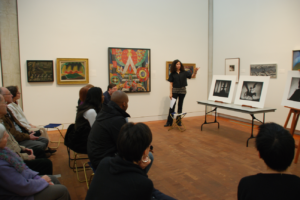Today’s post comes from Olivia Feltus, class of 2021 and Art Center Docent.

American, 1925-2008
Opal Gospel, 1971-1972
Acrylic and silkscreen in stainless steel case
Gift from the collection of Mr. and Mrs. Alexander E. Racolin
1995.14.11
On October 26th, 2017, poets and curators came together for a panel talk in exploration of Robert Rauschenberg’s Opal Gospel (1971) in which he used Native American texts to create a series of translucent prints. Opal Gospel, ten silkscreen prints on acrylic, is in the permanent collection of the Frances Lehman Loeb Art Center and was on view during this program. The three panelists were Patti Phagan, Curator of Prints and Drawings at the Loeb, Alyx Raz ’16, a former Art Center student docent who is currently pursuing their MFA in poetry at The University of Massachusetts Amherst, and Molly McGlennen, Vassar associate professor of English and Native American Studies.
This panel discussion was one of many public programs that were part of “The Big Read,” a project sponsored by the Poughkeepsie Public Library District and funded by the National Endowment for the Arts. This fall’s programs revolved around Native American poetry and specifically Joy Harjo’s book of poems, How We Became Human.
Robert Rauschenberg (American, 1925–2008) was a pioneering artist whose work in many mediums and many formats from the 1950s until his death in 2008 had an enormous influence on American art following the heyday of Abstract Expressionism. His Opal Gospel showcases Chippewa, Navajo, Apache, Nootka, Pawnee, and Iglulik texts through ten prints on Plexiglas panels stacked one behind the other on a lucite stand at uniform intervals. Rauschenberg intended viewers to interact with and rearrange the work, and with ten panels there are more than 3 million possible ways to arrange the prints.

American, 1925-2008
Opal Gospel, 1971-1972
Acrylic and silkscreen in stainless steel case
Gift from the collection of Mr. and Mrs. Alexander E. Racolin
1995.14.11
Patti Phagan led off the discussion, describing the work as “opalescent in every sense.” Phagan noted that the 1960s were a time of bold graphics, “flower power,” and elaborate album covers, all influenced by the pop art movement and permeating everyday life and pop culture. Along with these trends in popular graphics came a rejuvenation of the fine-art print. Universal Limited Art Editions (ULAE), a print publisher, started in 1957 and introduced printmaking to a new generation of artists including included Frank O’Hara, Larry Rivers, Jasper Johns, and Helen Frankenthaler, whose work is currently on view in the Loeb in the exhibition Fluid Expressions. Rauschenberg readily embraced printmaking, and the screenprint on Plexi became a significant part of his output.
Next, Alyx Raz brought their interpretations as a poet to the discussion, pointing to the question of “how to make sense of art with words” that Opal Gospel raises. Opal Gospel is meant to be touched, read and viewed. According to Raz, since the piece incorporates text, it requires one to look at the piece in light of extra complexities that are added by reading. Raz also stated that the textual aspect relates to its description as a “Gospel,” yet because the work was mass produced it inherently contradicts itself as a sacred piece.
Opal Gospel has recently come under critique by Native American artists and scholars. Some of these criticisms were brought to the conversation by Molly McGlennen, the third panelist, who contextualized the work within a larger pattern of appropriation of native cultures by non-native artists and within the pan-tribalism that characterized the 1960s and 1970s. She explored issues of cultural identity associated with the work, noting that although Rauschenberg identified as part Cherokee, one must be acknowledged as such by the nation in order to be Cherokee. She also noted that, interestingly, Rauschenberg did not include any Cherokee texts among those used in Opal Gospel.
McGlennen also described a recent exhibition of Opal Gospel at the Minneapolis Institute of Art, where it appeared alongside responses written by native artists about the work. Criticisms elicited by the work included that Rauschenberg was a perpetrator of “Indianness” in response to his usage of Native American texts, poor research, and statements that Rauschenberg did not interact with actual native people during the making of the piece. You can read about the museum’s approach here in an article by curator Jill Alberg Yohe.
With the three distinct viewpoints presented by the panelists in mind, participants in the event went into the galleries to view the work, where the conversation continued. The work was displayed in its original container, brought to light for consideration for a short but meaningful period of time. Opal Gospel commands the viewer to look into its layers and dimensions to individually interpret Rauschenberg’s craft, and this event allowed for that opportunity.

American, 1925-2008
Opal Gospel: When the Earth (Apache), 1971-1972
Acrylic and silkscreen
Gift from the collection of Mr. and Mrs. Alexander E. Racolin
1995.14.9




